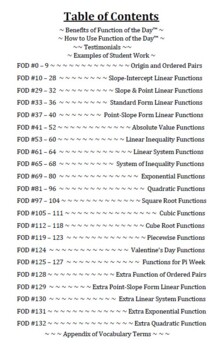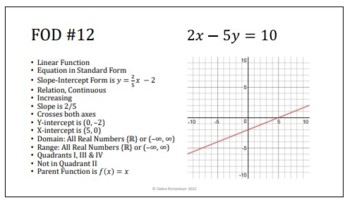Function of the Day for Algebra 1
Debra Richardson
8 Followers
Grade Levels
7th - 12th
Subjects
Resource Type
Standards
CCSS8.F.A.1
CCSS8.F.B.4
CCSS8.F.B.5
CCSSHSF-IF.A.1
CCSSHSF-IF.A.2
Formats Included
- PDF
Pages
80 pages
Debra Richardson
8 Followers
Description
Function of the Day is bell work for Algebra 1 classes. Present your class with a function each day and have students graph and analyze the function. Students can work independently or in small groups. Discuss facts about the function, reinforce the vocabulary terms and concepts. Algebra 1 Function of the Day book follows the order of curriculum for most Algebra 1 classes. Modify as needed. This bell work is great for ALL types of students, both low level and high level. Function of the Day teaches vocabulary, increases retention, and raises test scores! It's also a great cumulative review for ACT and SAT tests.
Total Pages
80 pages
Answer Key
N/A
Teaching Duration
1 Year
Report this resource to TPT
Reported resources will be reviewed by our team. Report this resource to let us know if this resource violates TPT’s content guidelines.
Standards
to see state-specific standards (only available in the US).
CCSS8.F.A.1
Understand that a function is a rule that assigns to each input exactly one output. The graph of a function is the set of ordered pairs consisting of an input and the corresponding output.
CCSS8.F.B.4
Construct a function to model a linear relationship between two quantities. Determine the rate of change and initial value of the function from a description of a relationship or from two (𝘹, 𝘺) values, including reading these from a table or from a graph. Interpret the rate of change and initial value of a linear function in terms of the situation it models, and in terms of its graph or a table of values.
CCSS8.F.B.5
Describe qualitatively the functional relationship between two quantities by analyzing a graph (e.g., where the function is increasing or decreasing, linear or nonlinear). Sketch a graph that exhibits the qualitative features of a function that has been described verbally.
CCSSHSF-IF.A.1
Understand that a function from one set (called the domain) to another set (called the range) assigns to each element of the domain exactly one element of the range. If 𝘧 is a function and 𝘹 is an element of its domain, then 𝘧(𝘹) denotes the output of 𝘧 corresponding to the input 𝘹. The graph of 𝘧 is the graph of the equation 𝘺 = 𝘧(𝘹).
CCSSHSF-IF.A.2
Use function notation, evaluate functions for inputs in their domains, and interpret statements that use function notation in terms of a context.





